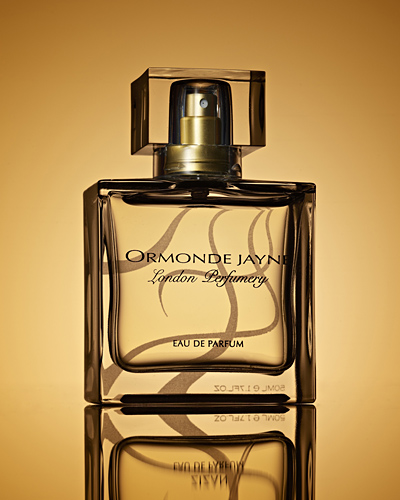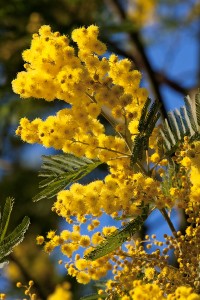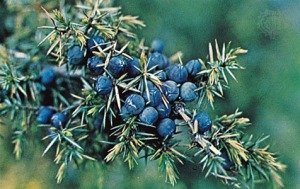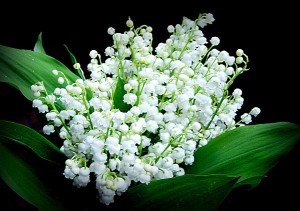Robert Piguet was one of the most famous of the Paris haute couture designers, a man who trained Givenchy, Balmain and Christian Dior himself, and, in 1944, he made perfume history when he released Bandit. It was a year before the end of WWII, and he had just sent his models down the runway in villain masks, brandishing knives, toy revolvers and reeking a “bad boy” image that was shocking for the times.

Bandit, original ad. Source: Fragrantica.
According to the Perfume Shrine, “it was this occasion that prompted Germaine Cellier to grab the models’ knickers after they had walked the catwalk, reputedly studying their scent in an effort to ‘capture the best of their femininity’ for the couturier’s first foray into fragrance. Whether she did and how one defines femininity in the first place is food for thought.”
The result was Bandit, one of the most famous leather scents in history, up there in the pantheon with Chanel‘s Cuir de Russie (1924/1927) and Knize Ten (1924). It was given a five-star rating by Luca Turin, and is consistently on three different “best of” lists: best leathers, best chypres, and best feminines for men. The perfume is repeatedly described as a tough, brutal “B****” with references to dominatrixes and how its unbearable in the best way possible. Love and awe echo constantly through the words.
Germaine Cellier made not only Bandit, but Piguet’s most famous scent of all, Fracas, the legendary benchmark for all white florals and the white light to Bandit’s black one. That contrast seems to have been intentional and may have stemmed from the dichotomy that was Cellier herself. According to the Perfume Shrine:
Cellier herself was outwardly conforming to all the perceived ideas of [femininity]: beautiful, slim, blond and tall, she exuded an air of elegance. Yet her reputation was tinged with shades of unconventionality and homosexuality and her creations were aiming to reflect different perceptions of Yin and Yang. Fracas was made for the femmes, Bandit was for the [tough lesbians].
To Fracas’s torrid tuberose that makes you either fall madly in love with or shun forever, Bandit juxtaposes daring, bitter green leather which, according to a male admirer smelling it, exudes aloofness, rebellious intellectuality and absolutely requires an expanse of skin to show for its sensuality to bloom.
In fact, Elena Vosnaki says Cellier was quite explicit in making the distinction between her two fragrances:
Cellier infamously dedicated Fracas ~a voluptuous tuberose scent conceived for ‘femmes’~ to the beautiful Edwige Feuillère, while she promised the butcher Bandit to the ‘dykes’.

Marlene Dietrich
Things are obviously different these days, and we are less obviously shocked by both sexual identities or preferences, but, in its time, Bandit was revolutionary. It was a bitter green, leather chypre that was nothing like the usual leathers or chypres on the market. It was androgynous, hard, edgy, and “beautiful but brutal,” to quote the famous perfumer, Guy Robert, who wrote about Cellier and her Bandit extensively in his book, Les Sens du Parfum. The epitome of the kind of woman who would wear it was not only Cellier herself, but Marlene Dietrich. And, in fact, it was Dietrich’s signature scent.

“Les Fleurs du Mal,” Charles Baudelaire.
If the accounts are true, then Bandit was the essence of Baudelaire’s “Les Fleurs du Mal,” capturing his theories of rotting excess, unconventional or anti-social eroticism, and slightly twisted malevolence. (Serge Lutens only wishes his Tubereuse Criminelle was about returning the evil back to the flowers!) Bandit horrified and bewitched people in equal measure, creating polarizing waves until sometime in the 1970s when it seemed to have faded into the mists. It’s unclear what happened to it or when.
Then, sometime, in the early to mid-1990s, perhaps 1996, it seems to have been re-released in Eau de Toilette form by Andrian Arpel for his company, Alfin. (Are you confused yet? We still have a way to go in this saga.) Arpel may have bought control of Robert Piguet, Inc. and hence, obtained the right to release a new version of Bandit. It is said to be far from the original scent, though there seems to be no consistent explanation as to why. Some say it is a more floral version that minimizes the leather. Others claim that the eau de toilette was just leather and civet, nothing more, and that it had almost nonexistent longevity.

Bandit, intermediary 1990s version from Arpel/Alfin, in Eau de Toilette form. Note the gold top.
Whatever its scent, it’s not too hard to determine the Arpel intermediary version because its bottle tops are gold, instead of the tradional Piguet black. Furthermore, according to the Perfume Shrine,
the eau de toilette that circulated under Andrian Arpel (Alfin inc. being his previous company name) bears this label:
Parfums ROBERT PIGUET
Made in France
For Alfin.inc
New York NY 10019
In 1999, however, the Robert Piguet brand was bought by Fashion Fragrances and Cosmetics (FF&C). They made every attempt to release a version of Bandit that was close to the original in terms of notes and appearance. Bandit was released in eau de parfum or extrait de parfum concentrations, and, like the original, comes in a black bottle with a black lid.
It is extremely difficult to keep track of the timeline and the different versions of Bandit but, to summarize, there was:
- original, vintage Bandit eau de parfum in a black bottle with a black lid, along with original, vintage Bandit extrait de parfum that had a crystal top to a black bottle.I have even seen all crystal bottles on eBay for the extrait de parfum or pure parfum version that are obviously really ancient, 1960s or 1970s bottles. Reports on Basenotes would seem to indicate that this was, indeed, the form for the super old extrait version;
- 1990s intermediary Bandit in eau de toilette concentration and in a black bottle with a gold top (which is frequently sold on eBay);
- post-1999 version in eau de parfum and extrait versions with the original black bottle and black lid.
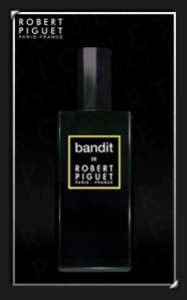
Bandit eau de parfum in its current bottle which is exactly like the original bottle.
I have always longed to smell original Bandit, but I was happy to obtain a sample of the post-1999 eau de parfum version from Surrender to Chance. (Surrender to Chance also carries the intermediary eau de toilette version and the post-1999 version in extrait or pure parfum form. Links will be at the end of this post.) I’m glad I had the chance now, as Robert Piguet announced a few months ago, in October 2012, that a new formulation of Bandit was under way due to the increasingly severe IFRA restrictions regarding oakmoss as an ingredient in perfumes.
The notes in Bandit are:
galbanum, artemisia, neroli, orange, ylang ylang, jasmine, rose, tuberose, carnation, leather, vetiver, oakmoss, musk, patchouli.
You can read the Glossary for further details but, in a nutshell, artemisia is wormwood and galbanum is a type of plant resin. According to the site, I Smell, Therefore I Am, galbanum has “a penetrating, pine-like top note and a slightly bitter, woody base.” Artemisia is said to smell like tarragon, concentrated to the umpteenth degree. It is pungent, bitter, bitter green, sharp, and frequently used along side oakmoss, patchouli or civet to cut through the cloying heaviness of those notes. In fact, it is said to be akin to a filtering lens that lets you diffuse some of the stronger ingredients (like civet, for example) and to let you smell the more subtle notes.
The galbanum and artemisia are apparent from the opening blast of Bandit. It is GREEEEEEEEN, in all capital letters! People weren’t kidding when they said this was a bitter green scent, but I am disappointed that there is none of that “blood-curdling scream” which I had expected from the opening. It is sharp, yes, but hardly as sharp or as pungent as I had expected. There is actually a slight softness, which surprises me. The scent is definitely vegetal and, for a few fleeting seconds, I sniff brackish, slightly funky, left-over vase water after some flowers have died. It is a note of faint decay that instantly makes me think of Les Fleurs du Mal but, to my surprise, I quite like it. It is nothing as offensive as the fetid, cloyingly filthy, murky, dead plant water scent that I have encountered in some other fragrances and, again, it is quite fleeting.
There is a greenness to Bandit that ranges all across the middle to darker end of the spectrum. At times, I feel as though I smell bright green, almost like absinthe but really closer to raw, young tree bark. Most of the time, however, I smell dark olive green with grey-green, the latter from the oakmoss in particular. The mental image is of one endlessly shimmering green haze where there are occasionally peeks of bright, glowing absinthe green, amidst the darkness of vegetal weeds, decaying herbs and bitter blackened woods.
Speaking of oakmoss, this is one very unusual oakmoss scent! It doesn’t have that dusty pungency that I can find so difficult in some chypre perfumes. There is no impression of dusty litchen or grey minerals pulverised into grey dust. No, this is a weirdly fresh sort of oakmoss, as if taken just seconds before off a tree. It feels living, almost. I suddenly start to understand all the comments about artemisia working as a filter or highlighter to some scents. It must be the artemesia which is cutting through some of the more dominant head notes in oakmoss and concentrating the smell of its essence at its freshest state. The oakmoss is so much more aromatically woody than the more cloying, pungent, almost excessively dusty and “old” notes that I often smell in chypre perfumes.
For much of the opening 15 minutes, Bandit is dominated by the pungent oakmoss, galbanum and artemisia. I don’t smell any of the orange citrus flowers mentioned in the notes and which usually herald the start of a chypre perfume. Instead, I smell carnation. Dry, green, and with just the faintest floral note to counter the bitter green vegetal and wood scent. There is also a faint hint of soap but, again, I’m surprised to like it. Perhaps because it’s not the waxy, cloying soap that I smell in perfumes with aldehydes, nor is it the synthetic, laundry detergent soap scent of so many modern perfumes today. It’s just an odd hint of fresh cleanness to counter the vegetal impression of weeds growing out of control at the base of a tree with bitter bark rolling off it and covered by fresh grey-green moss. There is vetiver, balsam-like pine, and something astutely noted by one commentator on Basenotes, MontMorency, that seems to resemble a salty, maritime note, like seaweed or kelp.
After an hour, the leather starts to make an appearance. It’s soft, softer than I had expected. That said, this is not soft leather that I’m smelling. It is not the soft, buttery, warm leather of a new jacket, nor the buttery leather of a car interior. This is all cold. It’s the cold, and most definitely black leather, of a whip. It’s a stony, severe, smell of leather. But, still, I’m disappointed. There is none of that “blood curdling” shriek, that almost horrified “dominatrix” or “bad ass biker chick” impression that I had read about repeatedly across different perfume sites like Fragrantica or Basenotes. There is no rubber, no harshness, none of what made Bandit so shocking. There is only one explanation: the current version is only a pale shadow of the original. (And the thought that this is going to be reformulated to an even weaker version is, quite frankly, rather horrific.)
Joining the leather are a few odd companions. I could swear that I smell camomile at one point, giving me an impression of softly herbal Alpine meadows and Heidi. There is also a faint animalistic muskiness but it’s not the harsh civet-type note of some animalic scents. The trio of Alpine Heidi, muskiness and the cold black leather of a whip has one final member: cigarettes. There is a fleeting, flickering whisper of an ashtray. Don’t get me wrong, I didn’t start smelling of a dirty ashtray. I still smelled mostly of dark green bitter woods, pungent moss and herbs, but the leather undertone had a faint whiff of ash at times, though it was extremely light.
It helps that Bandit’s leather tones were much closer to the skin than the more dominant green notes. The sillage on Bandit is huge, especially at first, but it surprised me by how quickly it became close to the skin for something that is consistently reported to be a powerhouse fragrance. The musky, leather undertones are all soft and close, almost intimate. It is incredibly sexy after such a fascinating start, and I resolve — for the umpteenth time — to try to get a hold of the vintage. Because, I have to be honest, I wanted so much more than what I got from this current version. More leather, more green, more pungency, more sillage, more of everything that I’m always reading about when it comes to Bandit. What I smell is so different and so intriguingly edgy that I dream about the vintage version.
Ultimately, the way Bandit smells on me is the way that the master perfumer, Guy Robert, describes the scent — only in a diluted, faint form. I cannot put it better than he did, so I shall use the Roberts quote provided on the Girvin blog:
[It is] “a beautiful but brutal perfume”, and that is as apt a description as any: Bandit is not a fragrance for the timid. It starts with heavy green notes, and moves slowly into a lovely floral blend with hints of spice, but the leather is apparent from the onset, and as it dries down, it is joined by an earthy-mossy accord that vaguely recalls a full ashtray. There is the slightest hint of powder, but it adds nothing of delicacy or girliness, and while Bandit stops short of being feral, the far dry down can only be described as decidedly animalic.
Like Fracas, Bandit is in-your-face sexy, but it is the dark, rebellious side of sexy — the bad girl, if you will. It is a sophisticated fragrance, mind you, but in spirit it is younger than Fracas, and it has more energy. Bandit is drinking and smoking and leather jackets, and running around at all hours getting into all sorts of mischief. I’ve been trying to think of what would be the modern version of such a fragrance, and nothing comes to mind: perhaps there is no such thing?
I wish my version of Bandit were the fierce Bandit that Robert encountered. I see her form and her face, but it’s hazy and faint. The leather is tamed, the animalistic musk is soft, and I smell absolutely none of the florals that are part of it. No jasmine, no tuberose, no ylang-ylang and definitely no rose. (I truly don’t think many people do, from what I’ve read. At least, not for the current eau de parfum formulation.) That said, I definitely agree with Guy Robert that Bandit is an extremely original scent and for a very original woman.
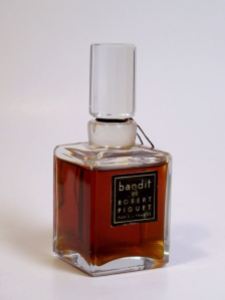
A 2 oz. bottle of vintage Extrait de Parfum, selling on eBay.
In my dreams, I buy the 2.0 oz/60 ml bottle of dark vintage pure parfum or extrait that is currently on eBay for $899. I splash it on, dress all in black in my leather jacket, leather pants and leather thigh-high boots, snap on some diamond earrings, put on my silver choker with spikes and baubles, along with the chunkiest of my men’s watches, then fly to Shanghai with nary a suitcase or companion. I would go to one of the dark, sophisticated bars in the old International District (I even know which one and they make a damn good cocktail!), and I would sip a bright green absinthe drink as I contemplated something infinitely risky, wild and dangerous. And I know I would get up to no good. No good at all! But that is the thing with Bandit, even in its diluted form. It seems oh so wrong, in such a good way.
DETAILS:
Sillage & Longevity: Great sillage for the first hour, then close to the skin. However, on others, it is reported to have enormous sillage for much, much longer. As for longevity, it is quite remarkable. On me, I could smell traces of it on my arm 8 hours after putting it on. It was soft, but it was there. On others, the longevity is reported to be even greater.
Cost & Availability: Bandit is available on the Robert Piguet website in all forms (except the rogue eau de toilette version), along with a body lotion version. The Eau de Parfum costs $95 for 1.7 oz/50ml and $135 for 3.4 oz/100 ml. The Parfum, pure parfum or extrait version costs $110 for 0.25 oz/7.5 ml and $235 for 1 oz/30 ml. In the US, you can also find Bandit available at Barneys, Bergdorf Goodman, Nordstrom, and various online retailers. In the UK, you can find Bandit at Harrods where it costs £75.00 for 1.7 oz/50 ml. In Australia, you can find Bandit on Libertine. You can also find Bandit on eBay, starting around $60 for the 1.7 oz size. But please, be careful as to which version you’re ordering and pay heed to the appearance of the bottles in the photos!
Samples: You can also order samples of Bandit from various sample sites. The one I use, Surrender to Chance, carries all versions of the scent except for the vintage. The mid-1990s Eau de Toilette version costs $3 for the smallest 1 ml sample vial, the Eau de Parfum costs the same, and the Pure Parfum costs $3.99 for 1/4 of the usual 1 ml vial, or $15.96 for the 1 ml vial. Surrender to Chance ships worldwide for about $5.95 (though it’s a little bit more for larger orders over $75), and for $2.95 for all orders within the U.S., regardless of the size of the order.
 be time to review one of those: Nuit de Tubereuse. As some of you know, I love tuberose, but I’m significantly underwhelmed by this 2010 creation from the legendary nose, Bertrand Duchaufour. Actually, to be completely frank, I’m not a fan.
be time to review one of those: Nuit de Tubereuse. As some of you know, I love tuberose, but I’m significantly underwhelmed by this 2010 creation from the legendary nose, Bertrand Duchaufour. Actually, to be completely frank, I’m not a fan.
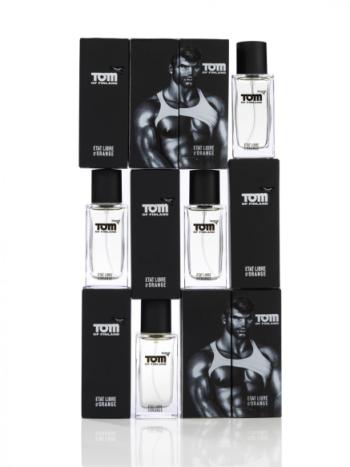



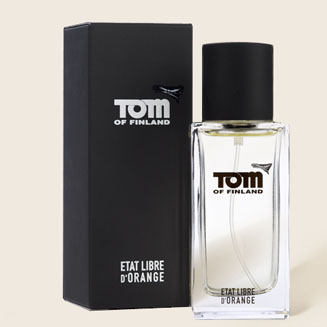
 Many people have complained that État Libre d’Orange Tom of Finland lacks roughness, toughness and any hint of male “body aromas” one would imagine emanating from a Tom of Finland-type man, but to me, the Tom of Finland man, like the fragrance, is clean (almost wholesome), wrinkle-free/smooth, and pale. For those who bemoan the lack of funk in this version, perhaps a Tom of Finland “rough seXXX” flanker will be forthcoming. [Emphasis added.]
Many people have complained that État Libre d’Orange Tom of Finland lacks roughness, toughness and any hint of male “body aromas” one would imagine emanating from a Tom of Finland-type man, but to me, the Tom of Finland man, like the fragrance, is clean (almost wholesome), wrinkle-free/smooth, and pale. For those who bemoan the lack of funk in this version, perhaps a Tom of Finland “rough seXXX” flanker will be forthcoming. [Emphasis added.]